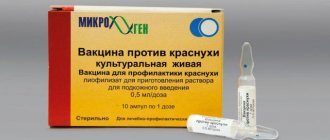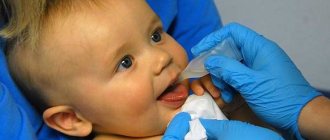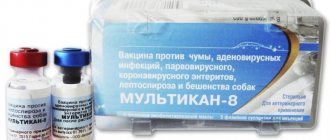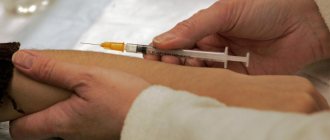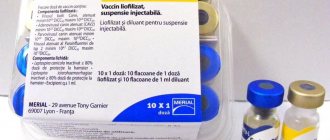Vaccine against VGBV
Vaccination is the most important measure for preventing common diseases in rabbits. Animals are usually vaccinated immediately after weaning from their mother. It is also necessary to pay attention to the vaccines that are used for young rabbits if you are planning to purchase such an individual. It is important, first of all, to ensure that rabbits are vaccinated against VGBV. They will cost the breeder significantly less than the cost of treatment, which is unlikely to lead to success.
The vaccine is made from VGBV strains B-87 and B-82. It has a dry porous structure and is supplied in bottles with a capacity of 10-20 cubic centimeters. This volume is enough for 5-12 doses. The vaccine is not capable of harming the health of the rabbit. After 3 days, immunity begins to form, which lasts up to 12 months.
It is important to take into account that it only makes sense to vaccinate healthy rabbits. In addition, veterinarians recommend getting rid of worms before vaccination. If the medicine enters the body of a sick individual, it can lead to death.
Optional vaccines
The presence of these vaccinations is not stipulated in the charters of nurseries, organizations, and agricultural farms. But in order to avoid an epidemic among young rabbits, it is better to protect yourself with additional procedures.
Veterinarians recommend injections for the following diseases:
- Salmonellosis . A dangerous virus for all mammals, even humans. It is transmitted by contact through bedding, bowls, shoes, and soil. The infection kills the tissues of the pulmonary apparatus and digestive organs, manifesting itself in the form of diarrhea, acute poisoning, and nasal discharge.
- Listeriosis. An incurable disease characteristic of pregnant rabbits and young animals. Affects the central nervous system and is spread by rodents. Leads to paralysis, miscarriages, and stillbirths. Transmitted to humans.
- Pasteurellosis. The infection develops in the bodies of dead animals and is transmitted through the air through contaminated food. Causes redness of the mucous membranes, high fever, diarrhea, nasal discharge, and difficulty breathing.
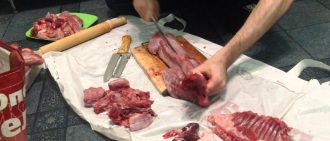
How to butcher a rabbit at home: what is needed, step-by-step instructions
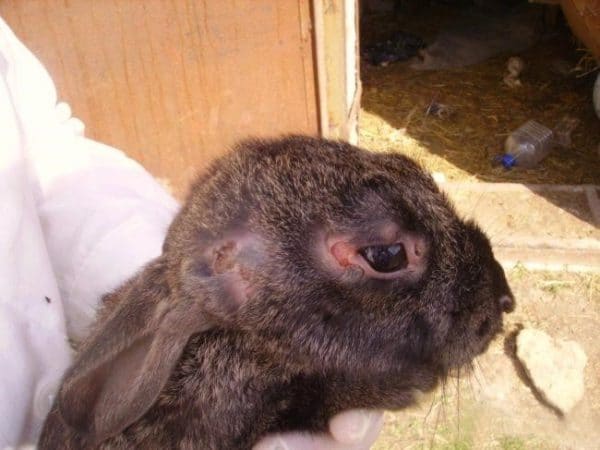
Salmonellosis
Attention! Although vaccinations for these diseases are not required, this does not make them any less contagious or dangerous. Mortality rates from salmonellosis are 90%.
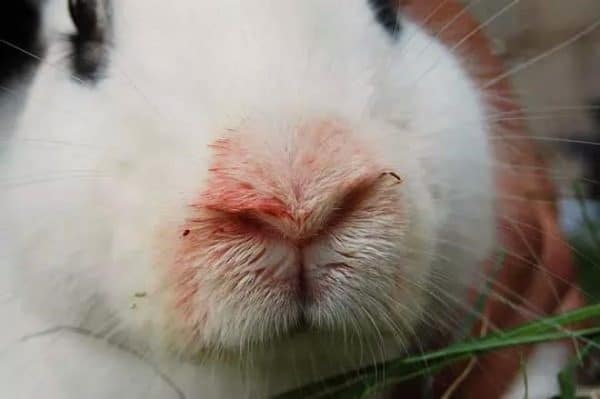
Pasteurellosis
VGBV infection
The disease is viral and therefore spreads quickly, affecting all animals in the population. The virus is resistant to changes in environmental conditions; preventive procedures do not reduce the risk of infection.
Transmission of myxomatosis, VGBK, occurs in two ways:
- direct contact with an infected animal, with bedding, or with the owner’s hands;
- the disease occurs after the bite of a blood-sucking insect. Fleas, midges, bitterns, and mosquitoes are carriers of this dangerous disease.
Important! Myxomatosis has a latent incubation period of 3 to 15 days, which should be taken into account during quarantine before scheduled vaccination.
Signs of infection
Animals develop a red rash and nodules on their ears. There may also be rashes in the eye area. There are two forms of the disease:
- The first (tumor). In this case, the animal’s temperature rises to 41 degrees. It does not subside until the first signs appear. The animal develops conjunctivitis: the eyes become red and fluid is released from them. Tumors are observed throughout the body and reach a diameter of 3-4 cm. The disease lasts 4-10 days, in some cases - one month. Pneumonia is life-threatening for the animal.
- The second (nodular) is characterized by the formation of dense, numerous tumors with a diameter of 0.5-2 cm. In the presence of this form, the animal’s temperature does not rise. The infection can remain in the body for more than 2 weeks. Then, in surviving animals, the tumors die off, and wound healing lasts for 2-4 weeks.
In recovered animals, immunity is formed, and for most, contracting the disease becomes harmless.
Nodular form of the disease
Another nodular form, although difficult to treat, many rabbits, about half of the herd, according to statistics, remain alive. The signs of this form are the following: nodules (small bumps) appear in different places, but more often on the head. They can disappear and then come back again. Most of these nodules occur in the area around the ears and eyes. Next, conjunctivitis appears with pus discharge, the rabbit’s eyelids close, he is unable to open them, because of this he does not see anything for some time. He is breathing heavily and has a runny nose.
What do you need to know to vaccinate yourself?
Here's what you need to pay attention to:
- The vaccine should be purchased only from specialized veterinary pharmacies. The use of vaccines purchased from other organizations is not permitted. The vaccine simply may not be beneficial, and it can also harm the health of the animal.
- You also need to remember that the vaccine is administered exclusively to healthy rabbits. In this regard, before performing the procedure, you must cure the animal of worms and other parasites.
- Helminths significantly weaken the body. Then the use of the drug can worsen the situation. Therefore, for animals, the deworming cycle is carried out at least one week before the scheduled vaccination time. An exception is allowed only if the planned deworming was carried out 2 months earlier.
- Conduct preliminary observation of rabbits for at least 2 days. Pay special attention to signs of poor health. If you notice lethargy, changes in the color and consistency of stool, or deterioration of the coat, do not vaccinate. In addition, the procedure is not performed if the temperature exceeds 38 degrees. If you find a high temperature, you need to figure out the cause as quickly as possible, eliminate it, and only then administer the medicine.
- If the rabbit did not cope well with transportation to the vaccination site, this will also be a reason for refusing the procedure. It is better to keep such an animal isolated until it gets stronger.
Vaccines for rabbits
All funds are divided into two types, determined by the presence of active or dead strains of the virus. There are live vaccines - they contain fragments of an active infection, to which the body reacts violently, but quickly builds protection.
The second type is inactivated. They differ in composition: the strains are dead, the reaction in rabbits is hidden, immunity takes longer to establish, but also lasts longer.
Mono-vaccines
At the moment, they are considered ineffective, they consist of strains of one virus, which is why the animal has to be pricked several times. At first glance, the drugs seem cheaper than polyvaccines, but this does not take into account the purchase of additional mixtures. The technology of use differs in that the solvent is often water rather than a solution.

Be sure to read:
How long do rabbits live depending on the breed, what affects life expectancy, how to extend
Complex vaccines
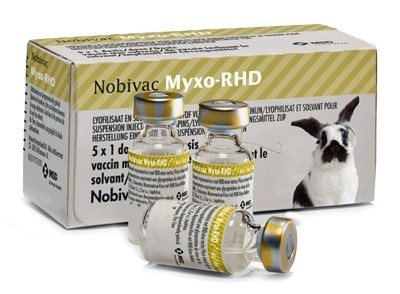
Vaccination with preparations containing strains of more than one virus is more profitable. Such vaccines are divided into bivalent (2 infections) and polyvalent (over 3 viruses).
In Russia, the first type is popular, providing protection against VGBK, myxomatosis:
- “Lapimun Hemix” (manufacturer – Ukraine);
- "Rabbiwak V" (domestic production);
- "Pestorin Mormix" (Poland);
- "Nobivak Mixo" (Holland);
Important! Additional vaccines are also complex. The drug "OKZ" is often used for salmonellosis, klebsiosis, and colibacillosis.
Although several diseases are more difficult to control, associated vaccinations are more effective. Firstly, the animal does not need to endure several injections or experience stress.
Secondly, the possibility of side effects is half that of a single-component medicine.
How to get vaccinated?
Experts advise contacting specialists to administer the vaccine. If the decorative rabbit lives at home, then purchase the medicine and take the rabbit to the veterinarian. If you are a large breeder and have a large number of rabbits, then it is possible to call a veterinarian to your home.
If such options are not possible, you can vaccinate yourself, strictly following the rules:
- The required composition is purchased only from trusted suppliers. It is important to check the expiration date, the corresponding quality certificate and the absence of signs of damage to the packaging and the bottles themselves.
- Before performing the procedure, carefully read the instructions included with the drug. Based on this, it is necessary to select the desired dosage. Also take into account the recommendations of your veterinarian.
- If the vaccine is sold in powder form, it is diluted with distilled water. If the kit comes with pre-mixed thinner, it is best to use that.
- If a disposable syringe is used in the process, it is replaced with a new one after each injection. The automatic syringe can be used without restrictions.
- Do not vaccinate rabbits if the air temperature exceeds 28 degrees.
The administration procedure is carried out according to the following scheme:
- The first injection is given when the rabbit is 0.5 months old. The second injection of the drug is given when he reaches the age of 4-4.5 months. Vaccination is then repeated every 12 months. It is advisable to administer the product in the spring. At this time, rabbits are most susceptible to disease.
- Injections must be made into the auricle, withers or thigh. Before administration, disinfect the injection site.
- The vaccine is administered intramuscularly or subcutaneously. The method of administration is selected based on the recommendations of the veterinarian and in accordance with the instructions.
- If side effects occur, you should immediately stop vaccination and consult a specialist.
- At the end of the procedure, injected rabbits must be isolated from other animals for 12-14 days.
- Also pay attention to the storage conditions of the vaccine. It is stored and transported at a temperature of 2-8 degrees. Neglecting storage conditions will lead to loss of properties of the drug.
A complex vaccine for rabbits prevents a number of viral and bacterial diseases that are typical for this type of animal. In addition, the medicine forms immune protection against several diseases at the same time, which significantly simplifies and reduces the cost of the vaccination process. It is important to strictly follow the recommendations for use, instructions and dosage when using such formulations.
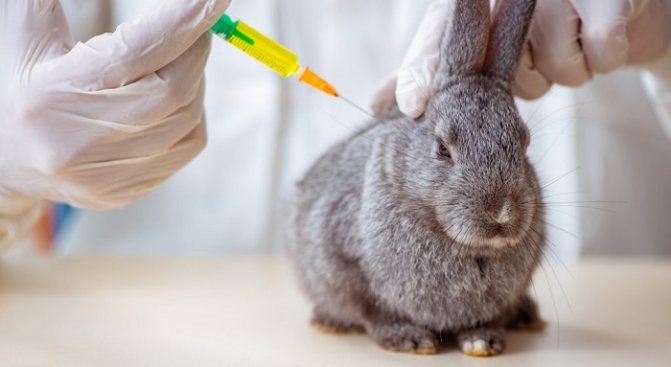
Vaccination scheme
Depending on the age, procedures for vaccination and revaccination of rabbits are carried out alternately. For babies who have not gained the required weight, vaccination is postponed. WITH
The cost at the clinic is 200-400 rubles.
| Age | Vaccine | Route of administration and dose |
| 28-30 days | Myxomatosis | 1 cube intramuscularly |
| 1.5 months | VGBK | 0.5 cc intramuscularly |
| 3 months | Solikoks (against coccidiosis) | Per 1 kg 0.4 ml with food (2 days in a row) |
| 4 months (and every six months) | Myxomatosis (revaccine) | 1 cube intramuscularly |
| 4.5 months (and every six months) | VGBK (revaccine) | 0.5 cc intramuscularly |
| 6-7 months (and annually) | Rabies | As recommended by your veterinarian |
Is it possible to vaccinate pregnant rabbits?
Regardless of the time of pregnancy, female rabbits can be vaccinated. The only exception is the lactation period - the antibodies contained in the drug negatively affect the body of rabbits.
It is recommended that pregnant rabbits receive complex vaccines, but only under the supervision of a doctor. Once the process is complete, you should closely monitor for any changes in behavior. If you notice alarming symptoms, you should immediately consult a specialist.
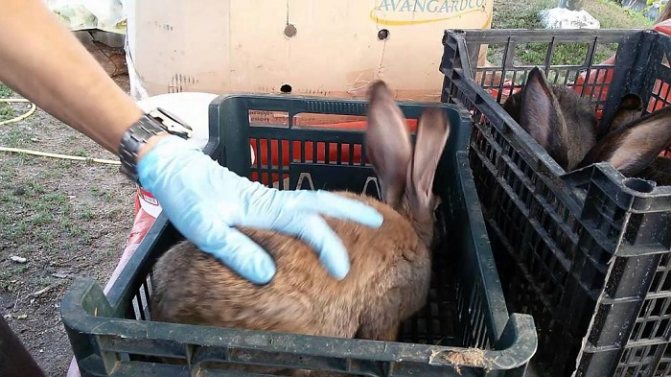
We vaccinate ourselves
Of course, giving vaccinations is the task of doctors. However, if you are not financially or physically able to turn to a professional, you can vaccinate your rabbits yourself.
To do this, follow these short instructions:
- Take the vaccine only from trusted people.
- Store the vaccine at a temperature of no less than +1 and no more than +9 degrees.
- Read the instructions. All necessary instructions are always described in the instructions, so be sure to read them first before starting the procedure.
- Avoid vaccination in hot weather. If the temperature is above 27 degrees, your rabbits may have difficulty withstanding the vaccination.
- If the vaccine is dry, dilute it with special vaccine water. You can buy it at the pharmacy. Or such water may be included with the vaccine.
- Use the vaccine right away. Once opened, it can be stored for no more than two hours.
- Give the injection as the instructions say. It can be intramuscular, intradermal or subcutaneous - all this is always indicated. You can do the vaccinations yourself in the rabbit’s thigh or withers.
It’s easy to vaccinate a rabbit yourself
How is the period after vaccination?
Vaccinated animals are kept in a separate cage for 2 weeks after treatment. This time is enough for the drug to begin to actively affect the body, after which vaccinated rabbits will no longer become infected with sick animals.
Usually healthy individuals feel great within 2-3 hours after the procedure. However, some of them have side effects:
- inflammation of the mucous membranes;
- active salivation;
- skin rash;
- lack of mobility.
Most often, such symptoms appear as a result of an allergic reaction, so it is necessary to inject 0.3 ml of suprastin subcutaneously into the animal. In case of arrhythmia, sulfocampocaine should be administered at the same dose.
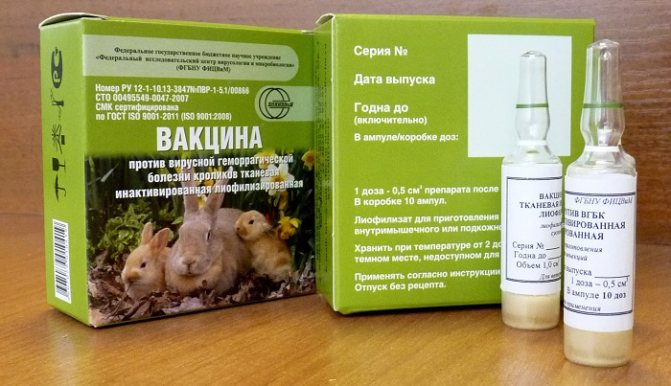
What diseases are rabbits vaccinated against?
There are 3 mandatory injections, without which rabbits are not allowed to participate in exhibitions, competitions, transportation across the border, or mating. In addition, the chance of survival of unvaccinated babies is low.
Rabbits receive their mother's immunity at birth, absorbing immune cells with milk. After feeding, they remain defenseless against the outside world and infections. Often it is the immature young that die out.
The most dangerous disease is rabbit viral hemorrhagic disease (RVHD) . The virus appeared in the 1980s, presumably from the PRC. It is transmitted from rabbit to rabbit through contact, use of the same bedding, cages, bowls, even when walking on the same soil. The infection cannot be transmitted to humans.
The fur of infected rabbits is also dangerous; it is aired out for 3-4 months before sale (and demand and price drop by 2-3 times). Symptoms: mucus from the nose, lack of appetite, high fever, convulsions.
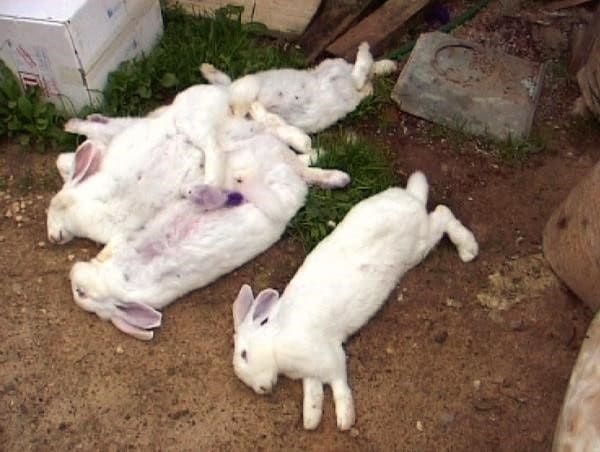
The most dangerous disease is rabbit viral hemorrhagic disease (RVHD)
Myxomatosis is an infection transmitted by contact by mosquitoes. Expressed by swelling of the mucous membranes, purulent conjunctivitis, painful neoplasms, tumors, blisters, crusts; secondary development of sexual problems.
It is transmitted and develops within a week. Unlike VGBK, cure is possible, but with a lightning-fast reaction to the first symptoms.
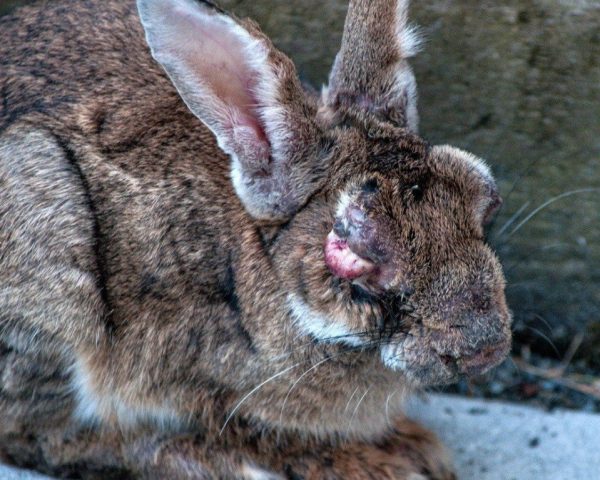
Myxomatosis
Rabies is a rare disease among rabbits, but it has been actively gaining popularity in recent years. Vaccination is mandatory for transporting pets.
The virus is dangerous for humans; a sick animal cannot be saved. Manifested by excessive salivation, aggressive behavior, epilepsy, photophobia.
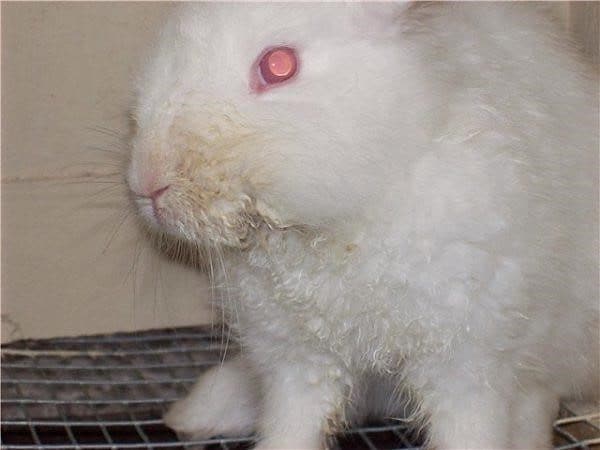
Rabies
Contraindications
Contraindications to the use of a combined vaccine against VGBV and Myxomatosis:
- incubation period of the disease;
- pathologies of various types;
- poor immunity;
- pregnancy and feeding period of rabbits;
- It is also not recommended to vaccinate rabbits if damage is found on the packaging of the medicine;
- expiration of the drug;
- rabbits that show signs of illness cannot be vaccinated;
- presence of helminths;
- non-compliance with vaccination and revaccination deadlines.
Because the associated vaccine has no medicinal properties, rabbits that are vaccinated during the incubation period of the disease may die.
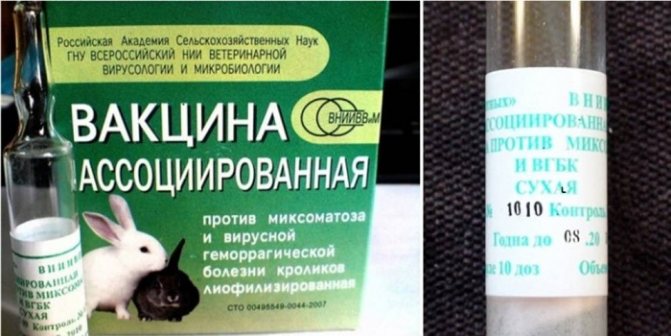
Will the vaccine help prevent the disease?
Unfortunately, there may not be a positive effect from vaccination. More often this happens due to mistakes made by rabbit owners who have not done everything possible to maintain strong immunity. In addition, the development of the disease can be affected by late administration of the drug, that is, vaccination is carried out after the rabbit has already contracted the disease.
Breeders must provide rabbits with proper care and good living conditions. In addition, the owner must take preventive measures in a timely manner. These rules will help avoid infection of rabbits before vaccination.
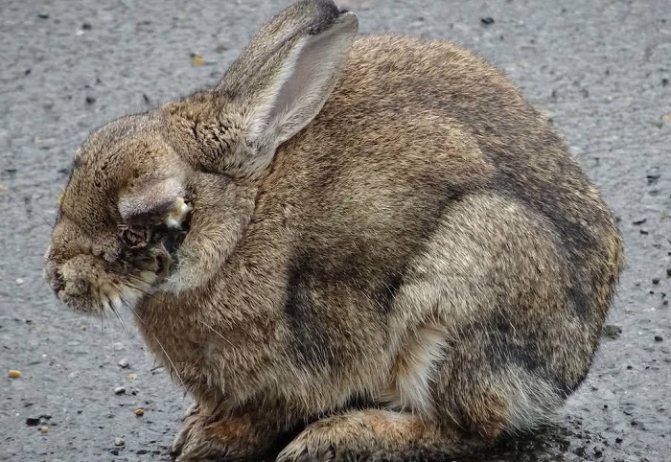
Rabbit with myxomatosis
Vaccination against myxomatosis
If you discover a disease on your farm or in your household, the sick rabbits are eliminated and the premises are thoroughly disinfected. If a rabbit has had myxomatosis but still survives, it will still remain a carrier of the virus and such a rabbit cannot be left in the herd. Healthy rabbits must undergo quarantine and vaccination.
- Vaccination should be carried out 2 times a year, from the age of one month, every September and March.
- Rabbits must be vaccinated 7 days after they are separated from their mother.
- When the rabbits are 2 months old, it is necessary to re-vaccinate young rabbits. And then vaccination is carried out every six months.
When should you not expect a positive result from a vaccine?
There are several reasons why vaccination results are not observed:
- Lethargic condition of animals immediately during vaccination;
- Infection of rabbits with helminths or infection;
- Expired vaccines were used;
- Possible infection of rabbits with VGBV already during vaccination. The animal was infected several days or even hours before vaccination.
- The schedule or dosage of vaccinations was violated.
- The breeder neglected the rules for preparing the animal for vaccination.
Important! Experts recommend vaccinating all rabbits without exception, even if there are no outbreaks of dangerous diseases.
What vaccines and when is best to do?
When it comes to vaccines (which ones and when to take), it is better to understand them in order.
What vaccines
There are two types of vaccines:
- Monovalent vaccine (against one disease, contains one type of pathogen).
- Associated vaccine (synonyms: complex, polyvalent, contains several pathogens).
Definitely, the use of monovalent vaccines ensures a significantly lower burden on the animal’s body and stronger and longer-lasting immunity. Therefore, in a situation where there is a threat of infection and vaccination is necessary at an earlier age, they are used.
For older animals or pets located in a safe region, a complex vaccine for rabbits can be quite successfully used to develop a good immune response.
Commonly used monovalent vaccines
Hemorrhagic disease
- "Pestorin" (Czech Republic).
- “Tissue inactivated vaccine against VGBV” (manufacturer: Pokrov, Russia).
- "Lapimun Gem" (produced by "BTL", Ukraine).
- Vaccine "Rabbivac V" (produced by LLC Trading House "BiAgro", Russia).
Myxomatosis
- “Vaccine against rabbit myxomatosis from strain B-82” (produced in Pokrov, Russia).
- "Miksoren" (Czech Republic).
- "Lapimoon Mix" (Ukraine).
- "Miksovak" (manufactured in Pokrov, Russia).
- "Rabbivac V" (produced by LLC Trading House "BiAgro", Russia).
Pasteurellosis
- "Pazorin-Ol" (produced by "Bioveta", Czech Republic).
- "Rabbivak R" (produced by LLC Trading House "BiAgro", Russia).
Rabies
- "Biocan R" (manufactured by "Bioveta", Czech Republic).
Fungal infections
- "Vakderm" (produced by "Vetzverocenter", Russia).
Listeriosis
- “Dry live vaccine against listeriosis of agricultural animals from the AUF strain” (Russia).
Returning to the question of when to do it, with the exception of the rabies vaccine, which is used after three months, monovalent vaccines can be used in rabbits starting at four weeks of age.
Most often, complex vaccination for rabbits is used to vaccinate decorative pets, as well as in prosperous farms.
Commonly used complex vaccines
Vaccination of rabbits against myxomatosis and VGBV
- "Pestorin Mormix" (Czech Republic).
- "Lapimun Hemix" (Ukraine).
- “Associated vaccine for rabbits against myxomatosis and VGBV” (produced in Pokrov, Russia).
- "Nobivak Myxo-RHD" (Netherlands). This is probably the best option for vaccinating pets, since the vaccine does not require revaccination upon initial administration, but must be repeated once a year.
These vaccines are used from six weeks of age.
Salmonellosis, colibacillosis
- “OKZ vaccine” against salmonellosis, colibacillosis, proteus, klebsiosis in agricultural and fur-bearing animals (produced by “Agrovetservis”, Ukraine).

